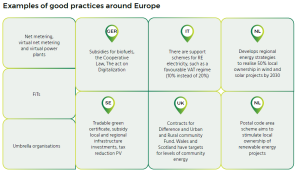7
Jenny Palm
Over the last few years, the European Union has begun to explicitly recognise the potential of energy communities in energy system decentralisation by giving citizens the right to actively participate in the production, storage and distribution of energy. This has given energy communities a new role in the institutional settings of the European Union and its member states. It has helped them establish a role in the energy transition in the eyes of society and has given them the legal recognition needed to develop further.
The inclusion of energy communities in new EU climate action strategies and policies promotes and enables their future development. However existing social and technical systems, developed for a more centralised energy system, often work against energy communities. The understanding of the environments that surround energy communities is crucial for helping them grow and establishing themselves in our day-to-day lives.
Case study
The Netherlands, a country with over 500 registered energy communities, has the ambition to realize 50 % local ownership in wind and solar projects by 2030 through the development of thirty regional energy strategies. The country has a policy instrument that aims to stimulate local ownership of renewable energy projects through its postal code area scheme (“postcoderoos”). These schemes are an example of a great energy community enabler.
Energy communities exist within larger systems and as such are influenced by the social, economic, political and technical conditions of their surroundings. The NEWCOMERS project has defined these conditions as national settings and has divided them into four categories: socio-economic conditions, technical systems, institutions and actors. Socio-economic conditions include aspects such as education, urbanisation and households’ economic situation, as well as more social aspects, such as trust. Technical systems include factors such as the energy mix, emissions, and the electricity grid. When talking about institutional settings, we look at policies and regulations that affect energy communities, both positively and negatively. And finally, actors are all institutions, individuals and organisations that play a role in energy community development.What are national settings?
Why do they matter?
National settings are the context in which energy communities emerge, exist and grow. They are the factors that enable their existence or make their establishment more difficult and set the conditions under which they operate. They affect the size, legal definitions and business models of energy communities, their financing and their role in national systems, how much energy they can produce, how and if they can sell it and so forth. An example of a barrier for energy communities are excessive bureaucracy and administrative costs, and lack of knowledge, while enablers may come in the form of tax reductions and support schemes, or the availability of technology such as smart metering.
Best practices
There is no one-fits-all recipe for energy communities. However, there are still several good practices developed and applied around Europe that have proven to be effective in supporting the development and growth of community energy.

